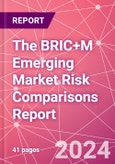The BRIC+M Emerging Market Risk Comparisons Report identifies the major near-term and long-term risks in leading emerging markets.
This includes country, region, economic and political risk in five of the world’s largest emerging markets (Brazil, China, India, Mexico and Russia) over the near-term (2010 to 2016) and the long-term (2017 to 2025). This report determines which of these emerging markets provide the greatest opportunity for both near-term and long-term business and investment success.
This includes both business opportunities in each emerging market as well as the impact of potential risk factors in each market. In addition, this report rates each emerging market in terms of business opportunities and risk levels, including the development of a ranking system for each emerging market covered in this study.
This includes country, region, economic and political risk in five of the world’s largest emerging markets (Brazil, China, India, Mexico and Russia) over the near-term (2010 to 2016) and the long-term (2017 to 2025). This report determines which of these emerging markets provide the greatest opportunity for both near-term and long-term business and investment success.
This includes both business opportunities in each emerging market as well as the impact of potential risk factors in each market. In addition, this report rates each emerging market in terms of business opportunities and risk levels, including the development of a ranking system for each emerging market covered in this study.
Table of Contents
- Afghanistan
- Albania
- Algeria
- Angola
- Argentina. Australia
- Austria
- Azerbaijan
- Bahrain
- Bangladesh
- Belarus
- Belgium
- Bolivia
- Bosnia and Herzegovina
- Botswana
- Brazil
- Bulgaria
- Cameroon
- Canada
- Chile
- China
- Colombia
- Congo-Brazzaville
- Congo-Kinshasa
- Costa Rica
- Cote d'Ivoire
- Croatia
- Cuba
- Czech Republic
- Denmark
- Dominican Republic
- Ecuador
- Egypt
- El Salvador
- Estonia
- Ethiopia
- Finland
- France
- Gabon
- Germany
- Greece
- Guatemala
- Honduras
- Hungary
- India
- Indonesia
- Iran
- Ireland
- Israel
- Italy
- Japan
- Jordan
- Kazakhstan
- Kenya
- Kuwait
- Latvia
- Lebanon
- Libya
- Lithuania
- Luxembourg
- Madagascar
- Malaysia
- Mexico
- Morocco
- Mozambique
- Myanmar
- Namibia
- Nepal
- Netherlands
- New Zealand
- Nicaragua
- Nigeria
- North Korea
- Norway
- Oman
- Pakistan
- Panama
- Paraguay
- Peru
- Philippines
- Poland
- Portugal
- Qatar
- Romania
- Russia
- Saudi Arabia
- Senegal
- Serbia
- Singapore
- Slovakia
- Slovenia
- South Africa
- South Korea
- Spain
- Sri Lanka
- Sudan
- Sweden
- Switzerland
- Syria
- Taiwan
- Tanzania
- Thailand
- Tunisia
- Turkey
- Turkmenistan
- Uganda
- Ukraine
- United Arab Emirates
- United Kingdom
- United States of America
- Uruguay
- Uzbekistan
- Venezuela
- Vietnam
- Yemen
- Zimbabwe) Region Reports (Central and South Asia
- East Asia and Pacific
- East Europe
- Middle East and North Africa
- North America
- South America
- Sub-Saharan Africa
- West Europe) Economic Forecasts (Central and South Asia
- East Asia and Pacific
- East Europe
- Middle East and North Africa
- North America
- South America
- Sub-Saharan Africa
- West Europe) Risk Forecasts (Central and South Asia
- East Asia and Pacific
- East Europe
- Middle East and North Africa
- North America
- South America
- Sub-Saharan Africa
- West Europe
Methodology
The publisher utilizes hundreds of local, national and international news and information sources for the creation and maintaining of all its reports and forecasts. Each news and information source is regularly checked to ensure accuracy and impartiality.
Analysts constantly monitor all sources of news and information to provide up-to-the-minute coverage for all of the countries and regions covered.
Methodology
- 900+ International Information and Data Sources
- Internal Analysis
- Preliminary Forecasts
- Review of 20+ Other Economic Forecast Sources Up-to-the-Minute Monitoring of Data and Events
- Application of Global and non-Economic Factors
- Monthly Economic Forecast Release
Key Forecast Variables:
- Local Economic Issues
- Global Economic Trends
- Regional Economic Trends
- Political Risk Factors
- Government Policy
- Demographic Trends
- Commodity Prices

LOADING...








